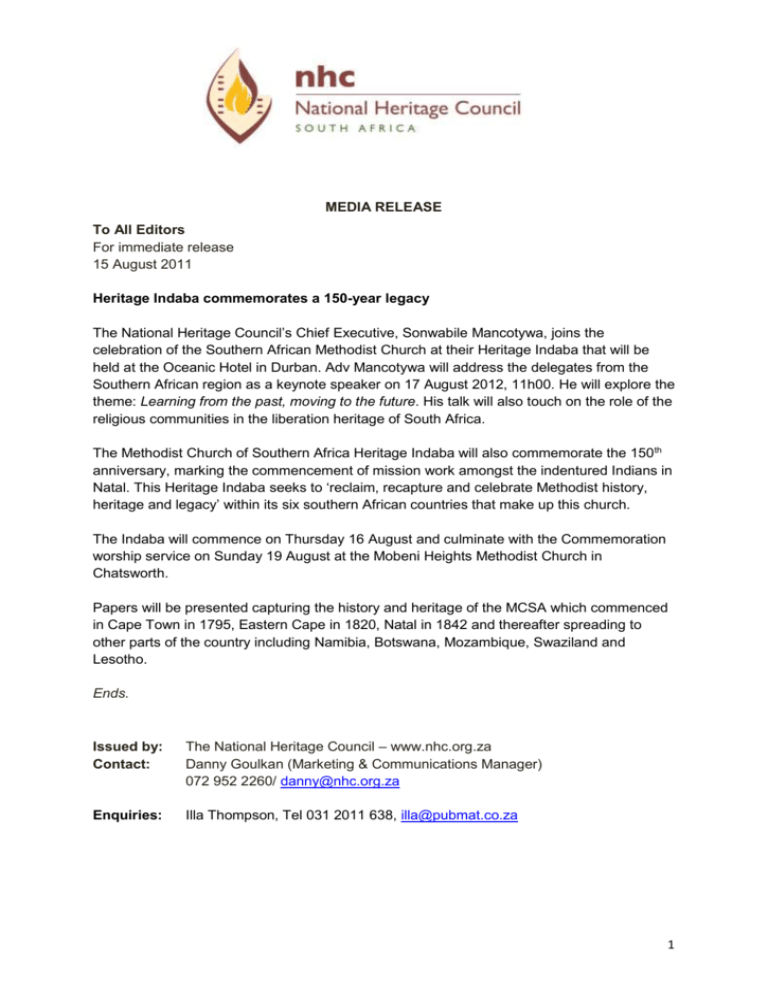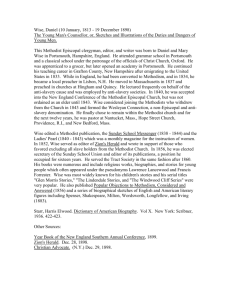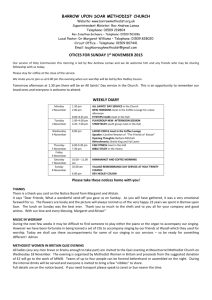Heritage Indaba commemorates a 150-year legacy
advertisement

MEDIA RELEASE To All Editors For immediate release 15 August 2011 Heritage Indaba commemorates a 150-year legacy The National Heritage Council’s Chief Executive, Sonwabile Mancotywa, joins the celebration of the Southern African Methodist Church at their Heritage Indaba that will be held at the Oceanic Hotel in Durban. Adv Mancotywa will address the delegates from the Southern African region as a keynote speaker on 17 August 2012, 11h00. He will explore the theme: Learning from the past, moving to the future. His talk will also touch on the role of the religious communities in the liberation heritage of South Africa. The Methodist Church of Southern Africa Heritage Indaba will also commemorate the 150th anniversary, marking the commencement of mission work amongst the indentured Indians in Natal. This Heritage Indaba seeks to ‘reclaim, recapture and celebrate Methodist history, heritage and legacy’ within its six southern African countries that make up this church. The Indaba will commence on Thursday 16 August and culminate with the Commemoration worship service on Sunday 19 August at the Mobeni Heights Methodist Church in Chatsworth. Papers will be presented capturing the history and heritage of the MCSA which commenced in Cape Town in 1795, Eastern Cape in 1820, Natal in 1842 and thereafter spreading to other parts of the country including Namibia, Botswana, Mozambique, Swaziland and Lesotho. Ends. Issued by: Contact: The National Heritage Council – www.nhc.org.za Danny Goulkan (Marketing & Communications Manager) 072 952 2260/ danny@nhc.org.za Enquiries: Illa Thompson, Tel 031 2011 638, illa@pubmat.co.za 1 Editor’s note: Media is welcome to attend HISTORY The Methodist Church of Southern Africa this year commemorates 150 Years of the Indian Missions in Natal which commenced in 1862. Together with this auspicious celebration, the Church also remembers other special milestones in the Methodist historical narrative: 175 years of celebration at the Somerset West Church in Cape Town, the Thaba ‘Nchu Mission in the Free State, and the 150th anniversary of the printing of the Xhosa Bible at Mt. Coke. Rich in heritage and boasting historical content, Methodism was originally introduced to South Africa by British soldiers stationed at the Cape in 1795. The Rev. Barnabas Shaw arrived in 1816 and laid the foundations of the Methodist pillars which would see the start of works at Lily Fountain in Namaqualand. Mission work thereafter advanced throughout the Cape and into modern Namibia. With the 1820 settlers who arrived at Port Elizabeth, was the Rev. William Shaw, who established a ‘chain of mission stations’ along this south eastern region of our sub-continent into the former Transkei. Amongst these were: Wesleyville, Mt. Coke, Butterworth, Mt. Morley, Clarkebury, Buntingville, Shawbury … These names tell of sacrificial service, of vulnerability in the face of danger, and of courageous witness in areas regularly ravaged by wars; but the missionaries persevered and their perseverance was rewarded. Crossing the Orange River from the Cape in 1823, were the Revs. Samuel Broadbent and Thomas Hodgson who established mission work amongst the Barolong at Maquassi. Unsettled, the Barolong and their missionaries wandered until they arrived at Thaba 'Nchu in 1833 where they established numerous stations in the Free State and Diamond Fields. The Rev. James Allison was to advance our work into Swaziland. The Rev. James Archbell came to Durban in 1842 to establish our witness. With the later arrival of numerous British settlers, Methodism spread to all parts of Natal. In 1847 the Rev Allison with a group of Swazi converts commenced our African work at Indaleni, which later led to the formation of the Nzondelelo movement that continues to support evangelists in KwaZulu Natal to the present day. A unique feature of the Methodist work in Natal was the mission to Indians who were imported as indentured labourers from India in 1860. The Rev. Ralph Stott, who had worked in Sri Lanka and was fluent in Tamil, established the mission in 1862 and spent his last 17 years in a strenuous ministry that bore little fruit at the time, but laid the foundations of a small but faithful Christian community. His son, the Rev. Simon Horner Stott continued the work, together with a succession of Indian evangelists and ministers and this led to the formation of three Indian Missions in Natal. Notably amongst these were the Choonoo’s, father and sons in Durban and Verulam, and the Rev. John Thomas in Pietermaritzburg. The Indian work no longer exists as a separate entity but Christians of Indian descent, play their part in a number of non-racial circuits.……………………………………………………………. Natal was the springboard from which Methodism entered the Transvaal. From 1871 ministers were appointed to Potchefstroom and Pretoria and numerous churches were established in various places. The return to Swaziland was led by the Rev. Daniel Msimang some 35 years after he went into exile with Rev. Allison. Since 1850, Methodist mission work in Mahikeng was established and maintained by Molema, the first member of the chiefly family converted at Thaba ‘Nchu. From here Methodism spread to Botswana. 2 Another lay person Robert Mashaba took Methodism back to his home country, Mozambique. After being prevented from entering Lesotho for many years, our Methodist witness was established there in the 1920’s. Methodists were present as new villages, towns and cities were established throughout Southern Africa; and new preaching places, Societies and Circuits were opened. Many local people heard Christ’s call to proclaim the gospel. Among them were Jacob Links in Namaqualand, Molema who ministered among the Barolong of Botswana, David Magatha at Potchefstroom, Hans Aapje among Makapan’s people, Samuel Mathabathe in Sekukhuniland, Robert Mashaba at Delagoa Bay, and in the Indian Mission John Choonoo, Isaac Chinnasami, Moses Boloo and Billy Christopher, to name but a few. 3








